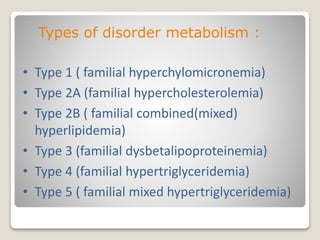Types of disorder metabolism include:
- Type 1 (familial hyperchylomicronemia) characterized by massive fasting hyperchylomicronemia due to lipoprotein lipase deficiency. Treatment is a low fat diet.
- Type 2A (familial hypercholesterolemia) caused by LDL receptor defects, leading to increased LDL and risk of heart disease. Treated with diet and drugs like statins.
- Type 2B (familial combined hyperlipidemia) caused by overproduction of VLDL, increasing triglycerides and cholesterol. Managed with lifestyle changes and medication therapy.















![Treatment :
There is currently no pharmacotherapy approved in the United
States to treat patients with FCS.
Though there is anecdotal evidence that some patients MAY benefit
from approved triglyceride lowering medications [fibrates, niacin
(nicotinic acid) or statins (HMG-CoA reductase inhibitors)], FCS
experts believe that strict adherence to a low fat diet is the only
effective way to manage FCS.
Plasmapheresis (removal, cleaning, and reinsertion of patient’s
blood/plasma) may be necessary for some patients.
The possibility of gene therapy for FCS is currently being explored.](https://image.slidesharecdn.com/disordermetabolism-151125181101-lva1-app6891/85/Disorder-metabolism-16-320.jpg)
















